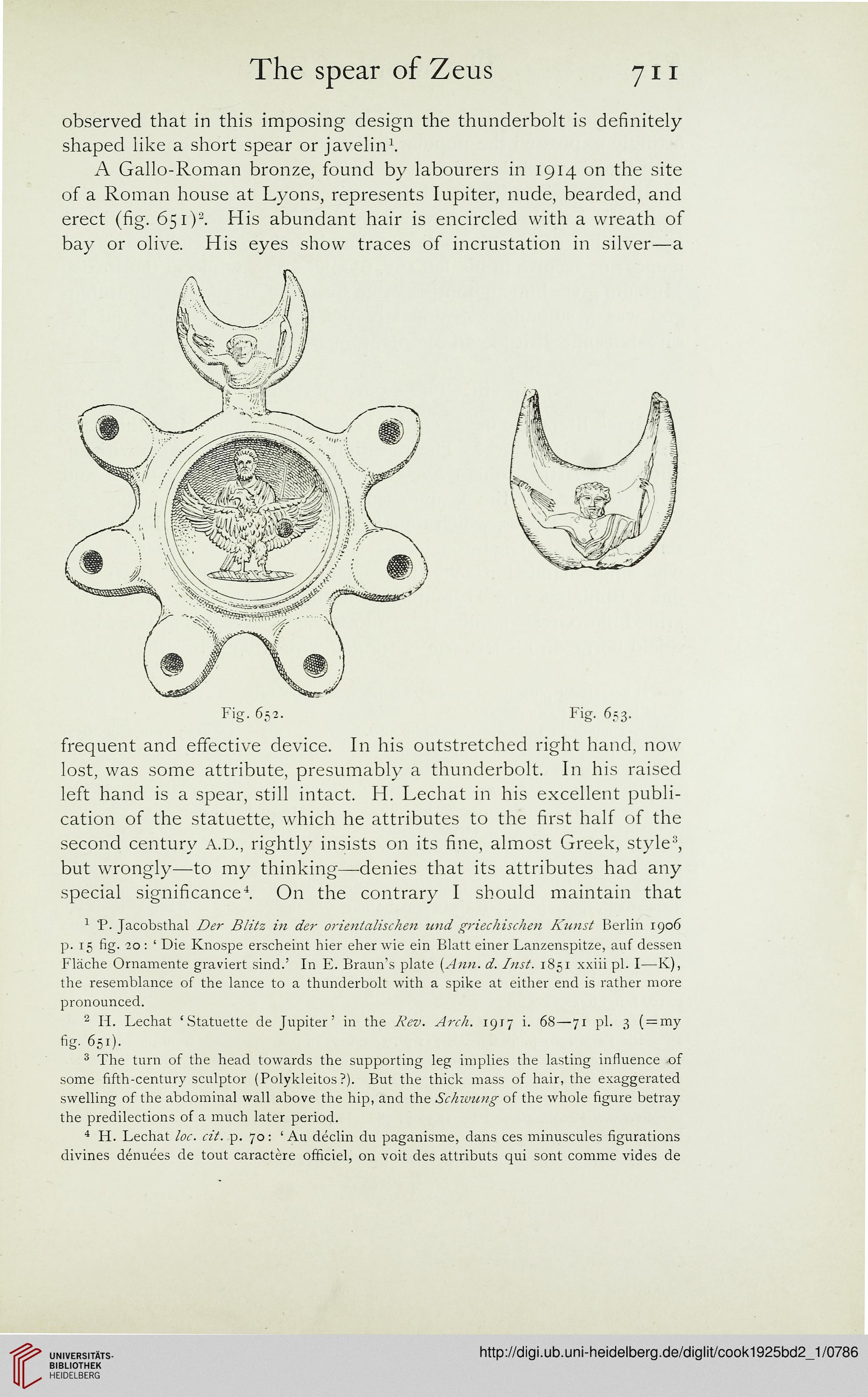The spear of Zeus
711
observed that in this imposing design the thunderbolt is definitely
shaped like a short spear or javelin1.
A Gallo-Roman bronze, found by labourers in 1914 on the site
of a Roman house at Lyons, represents Iupiter, nude, bearded, and
erect (fig. 651)-. His abundant hair is encircled with a wreath of
bay or olive. His eyes show traces of incrustation in silver—a
Fig. 652. Fig. 653.
frequent and effective device. In his outstretched right hand, now
lost, was some attribute, presumably a thunderbolt. In his raised
left hand is a spear, still intact. H. Lechat in his excellent publi-
cation of the statuette, which he attributes to the first half of the
second century A.D., rightly insists on its fine, almost Greek, style3,
but wrongly—to my thinking—denies that its attributes had any
special significance4. On the contrary I should maintain that
1 "P. Jacobsthal Der Blitz in der orientalischen und griechischen Kunst Berlin 1906
p. 15 fig. 20: ' Die Knospe erscheint hier eher wie ein Blatt einer Lanzenspitze, auf dessen
Flache Ornamente graviert sind.' In E. Braun's plate {Ann. d. Inst. 1851 xxiii pi. I—K),
the resemblance of the lance to a thunderbolt with a spike at either end is rather more
pronounced.
2 H. Lechat 'Statuette de Jupiter' in the Rev. Arch. 1917 i. 68—71 pi. 3 ( = my
fig. 651).
3 The turn of the head towards the supporting leg implies the lasting influence of
some fifth-century sculptor (Polykleitos?). But the thick mass of hair, the exaggerated
swelling of the abdominal wall above the hip, and the Schivtmg of the whole figure betray
the predilections of a much later period.
4 H. Lechat loc. cit. p. 70: ' Au declin du paganisme, dans ces minuscules figurations
divines denuees de tout caractere officiel, on voit des attributs qui sont comme vides de
711
observed that in this imposing design the thunderbolt is definitely
shaped like a short spear or javelin1.
A Gallo-Roman bronze, found by labourers in 1914 on the site
of a Roman house at Lyons, represents Iupiter, nude, bearded, and
erect (fig. 651)-. His abundant hair is encircled with a wreath of
bay or olive. His eyes show traces of incrustation in silver—a
Fig. 652. Fig. 653.
frequent and effective device. In his outstretched right hand, now
lost, was some attribute, presumably a thunderbolt. In his raised
left hand is a spear, still intact. H. Lechat in his excellent publi-
cation of the statuette, which he attributes to the first half of the
second century A.D., rightly insists on its fine, almost Greek, style3,
but wrongly—to my thinking—denies that its attributes had any
special significance4. On the contrary I should maintain that
1 "P. Jacobsthal Der Blitz in der orientalischen und griechischen Kunst Berlin 1906
p. 15 fig. 20: ' Die Knospe erscheint hier eher wie ein Blatt einer Lanzenspitze, auf dessen
Flache Ornamente graviert sind.' In E. Braun's plate {Ann. d. Inst. 1851 xxiii pi. I—K),
the resemblance of the lance to a thunderbolt with a spike at either end is rather more
pronounced.
2 H. Lechat 'Statuette de Jupiter' in the Rev. Arch. 1917 i. 68—71 pi. 3 ( = my
fig. 651).
3 The turn of the head towards the supporting leg implies the lasting influence of
some fifth-century sculptor (Polykleitos?). But the thick mass of hair, the exaggerated
swelling of the abdominal wall above the hip, and the Schivtmg of the whole figure betray
the predilections of a much later period.
4 H. Lechat loc. cit. p. 70: ' Au declin du paganisme, dans ces minuscules figurations
divines denuees de tout caractere officiel, on voit des attributs qui sont comme vides de




